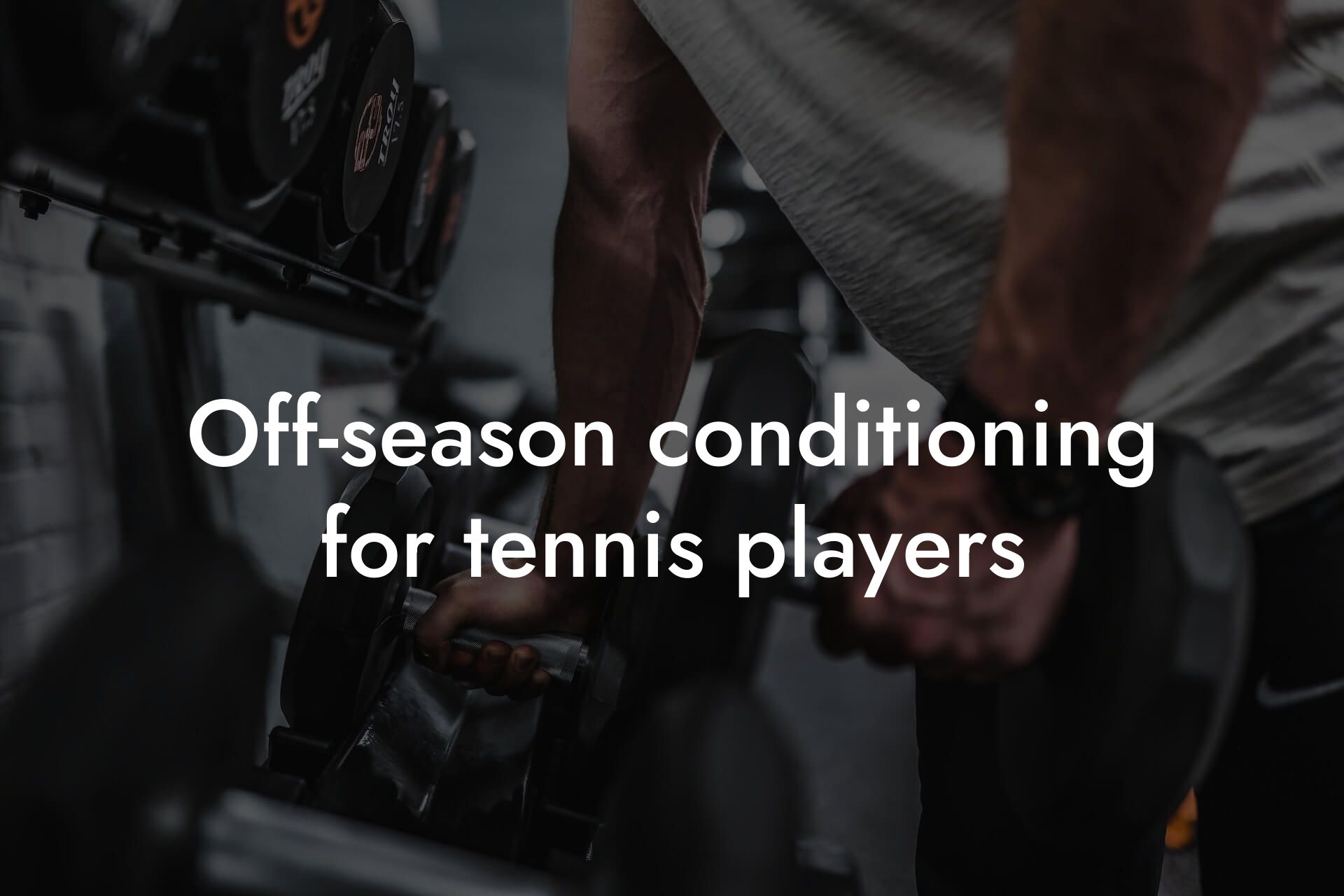As a high-earning professional, you understand the importance of maintaining a healthy and fit physique. In tennis, agility and speed are crucial components of success on the court. However, many tennis players overlook the significant impact of body composition on their performance. In this article, we'll delve into the relationship between body composition and tennis agility, and provide you with actionable insights to take your game to the next level.
Table of Contents
What is Body Composition?
Body composition refers to the proportion of fat mass and lean mass in your body. Lean mass includes muscle mass, bone density, and water content, while fat mass consists of essential fat (necessary for bodily functions) and non-essential fat (stored energy). A healthy body composition is essential for optimal physical performance, including tennis agility and speed.
The Impact of Body Fat on Tennis Agility
Excess body fat can significantly hinder tennis agility and speed. Carrying extra weight increases the energy expenditure required for movement, making it more challenging to accelerate, decelerate, and change direction quickly. Additionally, excess fat can lead to reduced power output, decreased reaction time, and increased risk of injury. Even a small reduction in body fat percentage can result in significant improvements in tennis agility and speed.
The Role of Muscle Mass in Tennis Agility
Muscle mass plays a critical role in tennis agility and speed. Having adequate muscle mass enables you to generate force, power, and speed, allowing you to cover the court more efficiently. Well-developed muscles in the legs, core, and upper body are essential for explosive movements, quick changes of direction, and rapid acceleration. A higher muscle mass percentage can also improve your overall endurance and reduce fatigue during long matches.
Bone Density and Tennis Agility
Bone density is often overlooked in discussions about tennis agility, but it's a crucial component of overall athletic performance. Strong bones provide a solid foundation for muscle attachment, allowing for more efficient force production and transmission. Adequate bone density also reduces the risk of injuries, particularly stress fractures, which can be debilitating for tennis players. A DEXA scan can provide valuable insights into your bone density, helping you identify areas for improvement.
The Importance of Visceral Fat in Tennis Agility
Visceral fat, also known as belly fat, is a type of fat that accumulates around the abdominal organs. Excess visceral fat is linked to a range of health issues, including insulin resistance, metabolic syndrome, and cardiovascular disease. In tennis, visceral fat can impede agility and speed by reducing muscle function, increasing inflammation, and altering hormone production. Maintaining a healthy visceral fat level is essential for optimal tennis performance.
How to Optimize Body Composition for Tennis Agility
To optimize body composition for tennis agility, focus on the following strategies:
- Resistance training: Incorporate exercises that target multiple muscle groups, such as squats, lunges, and deadlifts, to build muscle mass and strength.
- High-intensity interval training (HIIT): Incorporate HIIT workouts to improve cardiovascular fitness, increase speed, and enhance agility.
- Proper nutrition: Focus on a balanced diet that includes lean protein sources, complex carbohydrates, and healthy fats to support muscle growth and recovery.
- Get enough sleep: Adequate sleep is essential for muscle recovery, hormone regulation, and overall athletic performance.
- Monitor body composition: Regularly track your body composition using a DEXA scan or other methods to ensure you're making progress towards your goals.
In conclusion, body composition plays a critical role in tennis agility and speed. By maintaining a healthy body fat percentage, building muscle mass, optimizing bone density, and reducing visceral fat, you can improve your overall athletic performance and dominate on the court. Remember to focus on a balanced training program, proper nutrition, and adequate sleep to support your body composition goals. At Tano Performance Group, we're dedicated to helping high-earning professionals like you achieve their physical goals and take their business to the next level. Contact us today to learn more about our comprehensive body assessment services using DEXA technology.
Frequently Asked Questions
What is body composition, and how does it impact tennis agility and speed?
Body composition refers to the percentage of fat and lean mass in the body. A high percentage of body fat can negatively impact tennis agility and speed, as excess weight can slow down movement and reaction time. On the other hand, a high percentage of lean mass, particularly in the legs and core, can improve power, acceleration, and overall tennis performance.
How does body fat percentage affect tennis performance?
Excess body fat can increase the risk of injury, reduce endurance, and slow down reaction time, ultimately affecting tennis performance. A higher body fat percentage can also lead to decreased agility, speed, and overall mobility on the court.
What is the ideal body fat percentage for tennis players?
The ideal body fat percentage for tennis players varies depending on the individual, but generally, a range of 6-12% for men and 16-23% for women is considered optimal. However, it's essential to note that body fat percentage is just one aspect of overall body composition, and lean mass is also crucial for tennis performance.
How does lean mass impact tennis agility and speed?
Lean mass, particularly in the legs and core, is essential for generating power, speed, and agility on the tennis court. A higher percentage of lean mass can improve acceleration, deceleration, and overall movement patterns, allowing tennis players to cover more court and react faster to their opponents' shots.
What are the benefits of increasing lean mass for tennis players?
Increasing lean mass can improve tennis performance by enhancing power, speed, and agility. It can also reduce the risk of injury, improve endurance, and enhance overall athleticism. Additionally, a higher percentage of lean mass can boost confidence and mental toughness, leading to a competitive edge on the court.
How can tennis players increase their lean mass?
Tennis players can increase their lean mass through a combination of proper nutrition, resistance training, and high-intensity interval training (HIIT). A diet rich in protein, complex carbohydrates, and healthy fats can provide the necessary building blocks for muscle growth and repair. Resistance training exercises, such as squats, lunges, and deadlifts, can help build strength and muscle mass in the legs and core. HIIT can improve cardiovascular fitness and enhance muscular endurance.
What is the role of bone density in tennis agility and speed?
Bone density plays a critical role in tennis agility and speed, as it affects the ability to generate force, power, and speed on the court. Tennis players with higher bone density tend to have stronger bones, which can improve their overall athleticism and reduce the risk of injury.
How can tennis players improve their bone density?
Tennis players can improve their bone density through a combination of weight-bearing exercises, resistance training, and proper nutrition. Weight-bearing exercises, such as jumping and hopping, can help stimulate bone growth and density. Resistance training exercises, such as squats and deadlifts, can also improve bone density by strengthening the muscles and tendons surrounding the bones. A diet rich in calcium, vitamin D, and other essential nutrients can provide the necessary building blocks for bone growth and repair.
What is the relationship between body composition and injury risk in tennis?
Body composition plays a significant role in injury risk in tennis. Excess body fat can increase the risk of injury, particularly in the lower extremities, as it can put additional stress on the joints and muscles. On the other hand, a high percentage of lean mass can reduce the risk of injury by improving strength, power, and overall athleticism.
How can tennis players reduce their risk of injury through body composition?
Tennis players can reduce their risk of injury through body composition by maintaining a healthy body fat percentage, increasing lean mass, and improving bone density. A well-structured training program that includes strength and conditioning exercises, as well as proper nutrition and recovery strategies, can help tennis players achieve optimal body composition and reduce their risk of injury.
What is the impact of body composition on tennis performance at different ages?
Body composition can impact tennis performance differently at various ages. For younger tennis players, a higher percentage of lean mass can improve power, speed, and agility. For older tennis players, maintaining a healthy body fat percentage and bone density can reduce the risk of injury and improve overall athleticism.
How can older tennis players maintain their body composition and performance?
Older tennis players can maintain their body composition and performance by incorporating age-specific training and nutrition strategies. This may include reducing the intensity and frequency of training, incorporating low-impact exercises, and focusing on functional strength and mobility exercises. A diet rich in protein, complex carbohydrates, and healthy fats can also help support muscle growth and repair.
What is the role of nutrition in body composition for tennis players?
Nutrition plays a critical role in body composition for tennis players, as it provides the necessary building blocks for muscle growth, repair, and recovery. A well-structured nutrition plan that includes a balance of protein, complex carbohydrates, and healthy fats can help tennis players achieve optimal body composition and improve their overall performance.
What are the key nutrients for tennis players to focus on for body composition?
The key nutrients for tennis players to focus on for body composition include protein, complex carbohydrates, healthy fats, calcium, vitamin D, and creatine. These nutrients can help support muscle growth, repair, and recovery, as well as improve bone density and overall athleticism.
How can tennis players periodize their nutrition to optimize body composition?
Tennis players can periodize their nutrition to optimize body composition by adjusting their macronutrient intake based on their training phase. For example, during intense training periods, tennis players may need to increase their carbohydrate intake to support energy production. During recovery periods, they may need to increase their protein intake to support muscle repair and recovery.
What is the role of recovery in body composition for tennis players?
Recovery plays a critical role in body composition for tennis players, as it allows the body to repair and adapt to the physical demands of tennis. Adequate recovery strategies, such as stretching, foam rolling, and proper sleep, can help tennis players maintain optimal body composition and reduce the risk of injury.
How can tennis players incorporate recovery strategies into their training program?
Tennis players can incorporate recovery strategies into their training program by scheduling regular recovery sessions, such as stretching and foam rolling, and prioritizing proper sleep and nutrition. They can also incorporate active recovery techniques, such as light cardio and strength training, to help promote blood flow and reduce muscle soreness.
What is the impact of body composition on mental toughness in tennis?
Body composition can have a significant impact on mental toughness in tennis, as a strong and lean physique can boost confidence and self-esteem. Conversely, excess body fat can lead to feelings of self-doubt and inadequacy, ultimately affecting mental toughness and performance on the court.
How can tennis players use body composition to improve their mental toughness?
Tennis players can use body composition to improve their mental toughness by focusing on building a strong and lean physique. This can be achieved through a combination of proper nutrition, resistance training, and high-intensity interval training. By achieving optimal body composition, tennis players can boost their confidence and self-esteem, ultimately improving their mental toughness and performance on the court.
What are the benefits of working with a sports dietitian or nutritionist for body composition?
Working with a sports dietitian or nutritionist can provide tennis players with personalized nutrition and recovery strategies tailored to their specific body composition goals. A sports dietitian or nutritionist can help tennis players optimize their macronutrient intake, develop a periodized nutrition plan, and provide guidance on recovery strategies and supplementation.
How can tennis players incorporate body composition into their overall training program?
Tennis players can incorporate body composition into their overall training program by setting specific goals and objectives, such as increasing lean mass or reducing body fat percentage. They can then develop a training program that includes a combination of strength and conditioning exercises, high-intensity interval training, and proper nutrition and recovery strategies to achieve their goals.
What are the common misconceptions about body composition in tennis?
Common misconceptions about body composition in tennis include the idea that a low body fat percentage is always optimal, or that muscle gain is only for strength athletes. However, tennis players require a balance of lean mass and body fat to optimize their performance and reduce their risk of injury.
How can tennis players avoid common mistakes when it comes to body composition?
Tennis players can avoid common mistakes when it comes to body composition by working with a qualified coach or trainer, setting realistic goals and objectives, and focusing on sustainable and long-term changes to their training and nutrition program. They should also avoid fad diets and quick fixes, and instead focus on making gradual and progressive changes to their body composition.
Here are some related articles you might love...
- Strength training programs for tennis athletes
- The importance of DEXA scans for tennis players
- Off-season conditioning for tennis players
- How to maintain endurance during long tennis matches
- The role of bone density in preventing tennis injuries
- Improving core strength for better tennis strokes
- Nutrition strategies for sustained energy during tennis matches
- Reducing body fat to enhance tennis performance
- Recovery techniques for tennis professionals
Zak Faulkner
Zak Faulkner is a leading authority in the realm of physical health and body composition analysis, with over 15 years of experience helping professionals optimise their fitness and well-being. As one the experts behind Tano Performance Group, Zak has dedicated his career to providing in-depth, science-backed insights that empower clients to elevate their physical performance and overall health.
With extensive knowledge of DEXA technology, Zak specializes in delivering comprehensive body assessments that offer precise data on body fat, muscle mass, bone density, and overall physique. His expertise enables individuals to make informed decisions and achieve their fitness goals with accuracy and confidence. Zak’s approach is rooted in a deep understanding of human physiology, combined with a passion for helping clients unlock their full potential through personalised strategies.
Over the years, Zak has earned a reputation for his commitment to excellence, precision, and client-focused service. His guidance is trusted by top professionals who demand the best when it comes to their health. Whether advising on fitness programs, nutritional strategies, or long-term wellness plans, Zak Faulkner’s insights are a valuable resource for anyone serious about taking their health and fitness to the next level.
At Tano Performance Group, Zak continues to lead our Content Team revolutionising how professionals approach their physical health, offering unparalleled expertise that drives real results.




